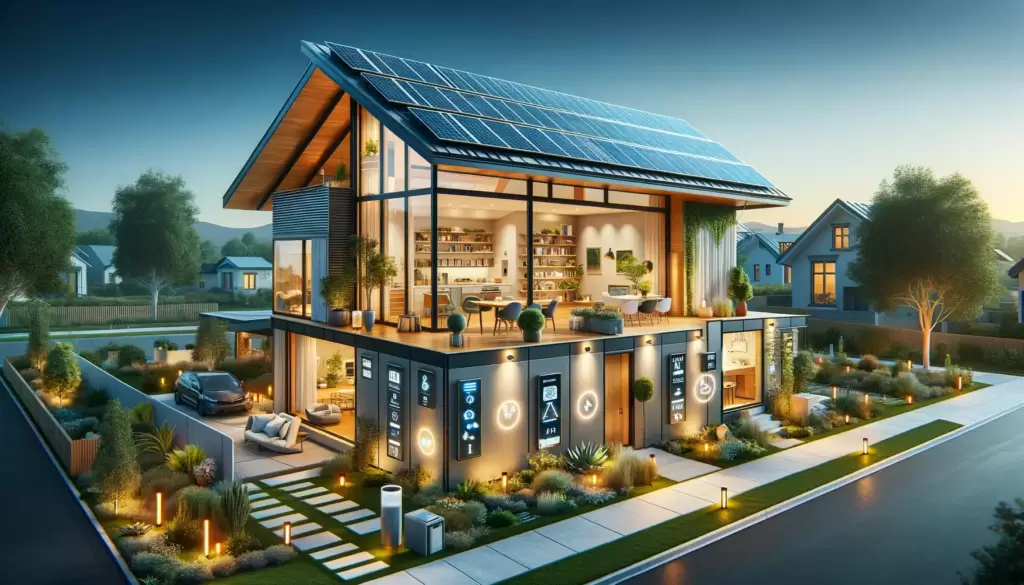Exploring the realm of Energy-Efficient Home Design Ideas in 2025, this introduction aims to captivate readers with a glimpse into the future of sustainable living. From cutting-edge materials to smart technologies, this overview sets the stage for an enlightening discussion on creating environmentally friendly homes.
Providing insights into the latest trends and advancements in energy-efficient home design, this paragraph sets the tone for an informative and engaging exploration of the topic.
Energy-Efficient Materials
In 2025, the focus on energy-efficient materials has led to the development of innovative options that can significantly reduce energy consumption in homes. These materials are designed to enhance insulation, regulate temperature, and minimize heat loss, ultimately leading to a more sustainable and cost-effective living environment.
Innovative Materials for 2025
- Smart Glass: Smart glass technology allows windows to adjust transparency based on external conditions, reducing the need for heating and cooling.
- Aerogel Insulation: Aerogel is a super lightweight material with exceptional thermal insulation properties, improving energy efficiency in walls and roofs.
- Phase Change Materials (PCM): PCM absorbs and releases heat to maintain a constant temperature, reducing the reliance on heating and cooling systems.
How These Materials Contribute to Energy Efficiency
The use of smart glass helps in optimizing natural light and heat, reducing the need for artificial lighting and heating. Aerogel insulation minimizes heat transfer, keeping indoor temperatures stable and reducing the workload on HVAC systems. Phase change materials regulate temperature fluctuations, reducing the energy required for maintaining a comfortable indoor environment.
Comparison with Traditional Materials
When compared to traditional materials like standard glass, fiberglass insulation, and concrete, these innovative materials offer superior energy efficiency benefits. They provide better insulation, reduce energy consumption, and contribute to a more sustainable living space. While the initial cost may be higher, the long-term savings in energy bills make them a worthwhile investment for homeowners looking to reduce their carbon footprint.
Smart Home Technology

Smart home technology has revolutionized energy-efficient home design by offering cutting-edge solutions to optimize energy use and reduce waste. These technologies leverage AI and IoT to create a more sustainable and comfortable living environment.
Energy Monitoring Systems
Energy monitoring systems allow homeowners to track their energy usage in real-time, providing valuable insights into where energy is being consumed. By identifying energy-intensive appliances or behaviors, residents can make informed decisions to reduce their consumption and lower their utility bills.
Smart Thermostats
Smart thermostats use AI algorithms to learn residents' behavior patterns and adjust temperature settings accordingly. By optimizing heating and cooling schedules based on occupancy and preferences, these devices can significantly reduce energy waste without sacrificing comfort.
Smart Lighting Systems
Smart lighting systems use sensors and timers to automatically adjust lighting levels based on natural light availability and occupancy. By only using energy when needed, these systems can reduce electricity consumption and extend the lifespan of light bulbs.
Home Automation Systems
Home automation systems integrate various smart devices in the home, allowing residents to control appliances, lighting, and HVAC systems remotely. By enabling more efficient management of energy-consuming devices, these systems contribute to overall energy savings and convenience.
Impact of AI and IoT
The integration of AI and IoT in energy-efficient home design has transformed how homes consume and manage energy. AI algorithms can analyze data from smart devices to optimize energy use, while IoT connectivity enables seamless communication between devices for a more coordinated and efficient home environment.
Renewable Energy Integration
Incorporating renewable energy sources like solar, wind, and geothermal power into home design is crucial for creating sustainable and energy-efficient living spaces. By harnessing these natural resources, homeowners can reduce their reliance on traditional fossil fuels, lower energy costs, and minimize their carbon footprint.
Solar Energy Integration
- One of the most popular renewable energy options for residential use is solar power. Solar panels can be installed on rooftops or in open spaces to capture sunlight and convert it into electricity.
- Benefits of solar energy integration include reduced electricity bills, lower environmental impact, and potentially even earning money by selling excess energy back to the grid.
- Advancements in solar technology, such as thin-film solar panels and solar shingles, make it easier for homeowners to incorporate solar energy into their homes seamlessly.
Wind Energy Integration
- Another renewable energy option for residential properties is wind power. Small wind turbines can be installed in yards or on rooftops to generate electricity from wind energy.
- Benefits of wind energy integration include a relatively low environmental impact, especially in windy regions, and the ability to generate electricity even when sunlight is limited.
- Considerations for wind energy integration include noise levels, zoning regulations, and the need for sufficient wind speeds to ensure efficient energy production.
Geothermal Energy Integration
- Geothermal energy utilizes the heat stored beneath the Earth's surface to provide heating and cooling for homes. Ground-source heat pumps can extract heat during the winter and release heat during the summer.
- Benefits of geothermal energy integration include high energy efficiency, consistent heating and cooling, and minimal environmental impact compared to traditional HVAC systems.
- Geothermal systems require significant upfront investment but can result in long-term energy savings and increased home value.
Passive Design Strategies

Passive design strategies focus on utilizing the natural elements of a building's surroundings to reduce energy consumption and create a comfortable living environment. By incorporating techniques such as orientation, insulation, and shading, homeowners can significantly decrease their reliance on artificial heating and cooling systems.
Orientation
Orientation plays a crucial role in passive design, as it determines how much sunlight enters a home. By positioning a house to maximize natural light exposure in winter and minimize it in summer, homeowners can take advantage of solar heat gain during colder months while reducing the need for air conditioning during warmer months.
Insulation
Proper insulation is key to maintaining a consistent indoor temperature without overworking heating and cooling systems. By investing in high-quality insulation materials for walls, floors, and roofs, homeowners can minimize heat transfer and keep their homes comfortable year-round.
Shading
Strategic shading techniques, such as awnings, trees, and trellises, can help prevent excessive heat gain in the summer without blocking natural light. By creating shade around windows and outdoor living spaces, homeowners can reduce the need for air conditioning and improve overall energy efficiency.
Integration into Modern Homes
Modern homes can incorporate passive design strategies through innovative architecture and building materials. For example, large windows with low-emissivity coatings can maximize natural light while minimizing heat loss. Additionally, green roofs and living walls can provide insulation and reduce the urban heat island effect.
Conclusion
In conclusion, the journey into Energy-Efficient Home Design Ideas in 2025 reveals a landscape of possibilities where sustainability meets innovation. With a focus on renewable energy integration, smart home technologies, and passive design strategies, the future of home design looks promising and eco-conscious.
Essential FAQs
What are the benefits of using renewable energy sources in home design?
Renewable energy sources reduce reliance on fossil fuels, lower electricity bills, and contribute to a cleaner environment.
How do smart technologies optimize energy use in homes?
Smart technologies automate energy consumption, adjust lighting and heating based on usage patterns, and enable remote control for efficient energy management.
What are some examples of innovative materials for energy-efficient home design in 2025?
Graphene-based materials, aerogel insulation, and self-healing concrete are some of the cutting-edge options that enhance energy efficiency in modern homes.








